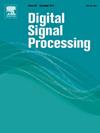A multi-scale refinement corner detection algorithm based on Shi-Harris
IF 2.9
3区 工程技术
Q2 ENGINEERING, ELECTRICAL & ELECTRONIC
引用次数: 0
Abstract
Corner detectors provide more structural and localization information with less redundancy than interest point detectors, which are very important in image processing tasks. This paper proposes a novel multi-scale refinement corner detection algorithm based on the Harris response function improved by Shi-Tomasi, integrating scale information into every step of corner extraction in the extremum point space. First, a new image information criterion, the spectral product, is proposed by analyzing the relationship between amplitude and frequency after Fourier transform of an image. This criterion combines the number of intensity variations represented by the frequency with the response strength represented by the amplitude. It is used to compute the mathematical relationship between scale and feature quantity, thereby constructing a corner density space. The number of stable corners at each scale is adaptively determined. Secondly, a new multi-scale separable gradient kernel is designed to adapt to scale variations and precisely compute image gradients. The proposed method further refines the sizes of the corner detection window and the non-maximal suppression window using hierarchical scale information. Finally, the criteria on region repeatability evaluation based on the Vggaffine dataset (under affine image transformation, JPEG compression, and viewpoint transformations) and Hpatches dataset (under viewpoint transformations) are used to evaluate the proposed detector against ten state-of-the-art methods. Experimental results demonstrate that the proposed detector outperforms all the tested methods.
求助全文
约1分钟内获得全文
求助全文
来源期刊

Digital Signal Processing
工程技术-工程:电子与电气
CiteScore
5.30
自引率
17.20%
发文量
435
审稿时长
66 days
期刊介绍:
Digital Signal Processing: A Review Journal is one of the oldest and most established journals in the field of signal processing yet it aims to be the most innovative. The Journal invites top quality research articles at the frontiers of research in all aspects of signal processing. Our objective is to provide a platform for the publication of ground-breaking research in signal processing with both academic and industrial appeal.
The journal has a special emphasis on statistical signal processing methodology such as Bayesian signal processing, and encourages articles on emerging applications of signal processing such as:
• big data• machine learning• internet of things• information security• systems biology and computational biology,• financial time series analysis,• autonomous vehicles,• quantum computing,• neuromorphic engineering,• human-computer interaction and intelligent user interfaces,• environmental signal processing,• geophysical signal processing including seismic signal processing,• chemioinformatics and bioinformatics,• audio, visual and performance arts,• disaster management and prevention,• renewable energy,
 求助内容:
求助内容: 应助结果提醒方式:
应助结果提醒方式:


